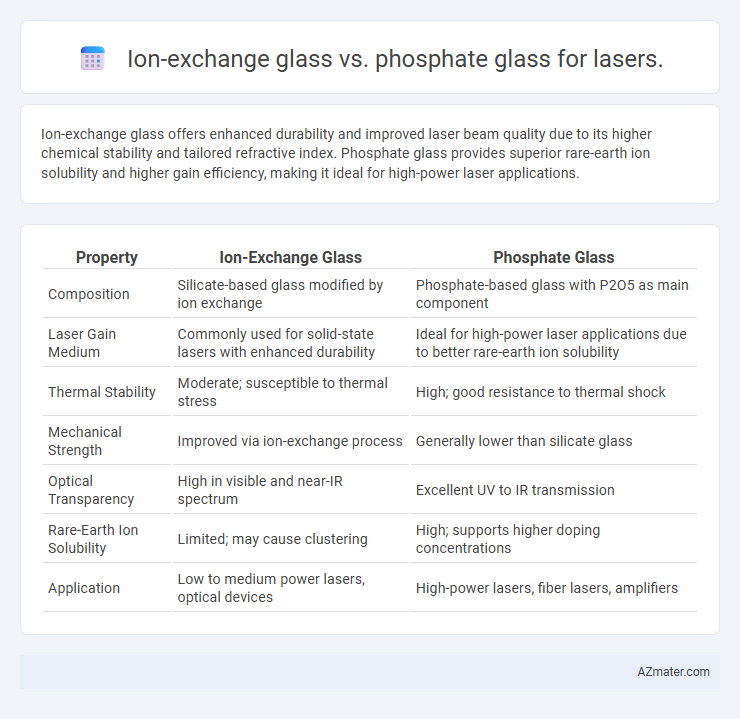Ion-exchange glass offers enhanced durability and improved laser beam quality due to its higher chemical stability and tailored refractive index. Phosphate glass provides superior rare-earth ion solubility and higher gain efficiency, making it ideal for high-power laser applications.
Table of Comparison
| Property | Ion-Exchange Glass | Phosphate Glass |
|---|---|---|
| Composition | Silicate-based glass modified by ion exchange | Phosphate-based glass with P2O5 as main component |
| Laser Gain Medium | Commonly used for solid-state lasers with enhanced durability | Ideal for high-power laser applications due to better rare-earth ion solubility |
| Thermal Stability | Moderate; susceptible to thermal stress | High; good resistance to thermal shock |
| Mechanical Strength | Improved via ion-exchange process | Generally lower than silicate glass |
| Optical Transparency | High in visible and near-IR spectrum | Excellent UV to IR transmission |
| Rare-Earth Ion Solubility | Limited; may cause clustering | High; supports higher doping concentrations |
| Application | Low to medium power lasers, optical devices | High-power lasers, fiber lasers, amplifiers |
Introduction to Laser Glass Materials
Ion-exchange glass and phosphate glass serve distinct roles in laser applications due to their unique chemical compositions and optical properties. Ion-exchange glass typically offers enhanced mechanical strength and improved ion conductivity, making it suitable for certain solid-state laser systems. Phosphate glass, characterized by its high rare-earth ion solubility and broad optical transparency, is preferred for high-power and ultrafast laser systems, enabling efficient energy storage and rapid pulse generation.
Overview of Ion-Exchange Glass
Ion-exchange glass is a specialized material commonly used in laser applications due to its enhanced surface strength and optical clarity achieved through ion-exchange processes, where smaller alkali ions in the glass matrix are replaced by larger ones, typically potassium. This modification significantly improves mechanical durability and resistance to laser-induced damage compared to phosphate glass, which, while prized for high rare-earth ion solubility and efficient lasing properties, generally exhibits lower chemical toughness. Ion-exchange glass is preferred in high-power laser systems requiring robust thermal and mechanical performance, making it ideal for precision optical components and high-reliability environments.
Characteristics of Phosphate Glass
Phosphate glass exhibits a unique structure characterized by low melting temperature and high rare-earth ion solubility, making it ideal for laser applications requiring efficient energy transfer and high gain. Its superior thermal stability and excellent resistance to crystallization enhance laser performance and durability compared to ion-exchange glass. The high transparency and tunable refractive index of phosphate glass further optimize laser beam quality and wavelength specificity.
Optical Properties: Ion-Exchange vs Phosphate Glass
Ion-exchange glass offers enhanced optical clarity and reduced scattering due to its controlled ion migration process, resulting in improved laser beam quality and efficiency. Phosphate glass exhibits broader transmission ranges and higher rare-earth ion solubility, making it ideal for high-power laser applications with efficient energy transfer. The choice between ion-exchange and phosphate glass depends on the specific laser wavelength requirements and the desired balance between optical transparency and thermal stability.
Laser Performance and Efficiency Comparison
Ion-exchange glass exhibits superior laser performance through enhanced thermal stability and higher damage thresholds, which result in increased power handling efficiency and prolonged operational lifespan. Phosphate glass offers higher rare-earth ion solubility, enabling greater gain and improved laser efficiency at shorter pulse durations but suffers from lower thermal conductivity and reduced damage thresholds. The choice between ion-exchange and phosphate glass depends on application-specific factors, prioritizing ion-exchange glass for high-power continuous-wave lasers and phosphate glass for pulsed laser systems requiring high gain.
Thermal and Mechanical Stability
Ion-exchange glass demonstrates superior mechanical stability due to surface compression layers formed during the ion-exchange process, enhancing resistance to cracking under thermal stress, making it well-suited for laser applications requiring robust performance. Phosphate glass, while offering excellent optical properties for laser mediums, exhibits lower thermal stability and mechanical strength compared to ion-exchange glass, limiting its use under high thermal load conditions. The thermal expansion coefficient of ion-exchange glass is typically lower, reducing thermal deformation and improving durability in high-power laser systems.
Doping Flexibility and Rare-Earth Incorporation
Ion-exchange glass offers superior doping flexibility by allowing precise incorporation of various rare-earth ions, enhancing laser performance through tailored optical properties and controlled ion distribution. Phosphate glass exhibits higher rare-earth solubility and homogeneous ion dispersion, enabling efficient energy transfer and reduced clustering, which boosts laser gain and brightness. The choice between ion-exchange and phosphate glass depends on specific laser application requirements, balancing doping complexity with optimal rare-earth integration for desired emission characteristics.
Applications in High-Power Laser Systems
Ion-exchange glass offers enhanced surface strength and durability, making it ideal for high-power laser systems requiring robust optical components that withstand intense thermal and mechanical stress. Phosphate glass provides superior rare-earth ion solubility and efficient fluorescence, crucial for high-gain laser amplifiers and ultra-short pulse generation in high-power laser applications. The choice between ion-exchange and phosphate glass depends on balancing mechanical resilience with optical performance in demanding high-power laser environments.
Cost Analysis and Manufacturability
Ion-exchange glass offers a cost-effective solution for laser applications due to its simpler manufacturing process and widespread availability of raw materials, resulting in lower production expenses compared to phosphate glass. Phosphate glass, while providing superior optical properties and higher damage thresholds, involves more complex synthesis and strict compositional control that increase manufacturing costs and limit scalability. The balance between initial material investment and long-term performance makes ion-exchange glass preferable for budget-sensitive projects, whereas phosphate glass suits high-performance lasers requiring advanced durability despite higher production costs.
Future Trends in Laser Glass Technology
Ion-exchange glass for lasers is advancing with enhanced ion mobility and structural stability, allowing improved high-power laser performance and thermal management. Phosphate glass exhibits increasing potential due to its superior rare-earth ion solubility and broad emission bandwidth, making it ideal for tunable and ultrafast laser applications. Future trends prioritize hybrid glass compositions and tailored doping techniques to optimize laser efficiency, durability, and wavelength versatility in next-generation photonics.

Infographic: Ion-exchange glass vs Phosphate glass for Laser
 azmater.com
azmater.com